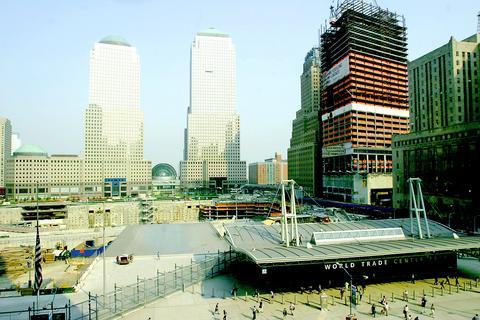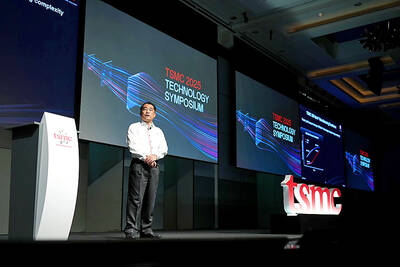The US is re-entering a long-abandoned race to the top of the manmade world today, as ground is broken for Freedom Tower on the scarred earth of Ground Zero.
The tower, meant to fill an aching void in Manhattan's skyline left by the destroyed World Trade Center, would rise to 1,776 feet (541m). The symbolic height honoring the US' Independence Day might make it the tallest building in the world.
But since planners unveiled the design in December, building experts have debated whether it will qualify as tallest, since the upper reaches are mostly vacant, filled with support cables and power-generating windmills.

PHOTO: NY TIMES
Any record also may be short-lived -- buildings are planned in the United Arab Emirates and South Korea that would dwarf the Freedom Tower by hundreds of feet.
America once dominated the ranks of the world's "supertall" skyscrapers with New York's Empire State Building and Chicago's Sears Tower the reigning champs for decades at a time. Now eight of the world's 10 tallest buildings are in Asia, thanks to a building frenzy begun in the early 1990s.
The Council on Tall Buildings and Urban Habitat in Chicago, a recognized arbiter, in April awarded the tallest title to the Taipei 101, a 508m tall pagoda-like tower in Taiwan. It surpassed Malaysia's twin Petronas Towers, completed in 1998, and bumped the 1974 Sears Tower to fourth place.
In Asia, "a lot of it has to do with the local governments wanting to put their flag in the ground and say, `We have arrived as an economy,'" said Ron Klemencic, the building council's chairman and president of Magnusson Klemencic Associates, a structural engineering firm in Seattle.
If skyscrapers were trees, then the supertalls would be redwoods -- an elite group that typically rise higher than 80 stories. Besides national pride, reasons to build so high include elevating broadcast antennas and satisfying the ego of a developer "with a checkbook that can make it happen," Klemencic said.
Typically, economics rather than engineering limit skyscraper height.
Practical matters
The cost of materials and moving people up and down restricts height, as does the space available for a building's footprint. In US cities with established urban layouts, it hasn't made financial sense to build extremely tall.
Supertall construction is more practical in places like the Middle East or China where there is no street grid and "you can just build it in the middle of the desert," Klemencic said.
Skyscraper building also has an apparent link to economic cycles, and the Asian construction trend reflects that, said Carol Willis, an architectural historian who founded the Skyscraper Museum in Manhattan.
"The tallest buildings always come at the end of a boom cycle and generally before a crash," she said, noting the building craze of the late 1920s.
Plans arise during good times when space is needed and rents promise profits, but buildings are often finished years later, adding excess office space to economies on the decline, Willis said.
However, the Freedom Tower, which may be completed before 2009, is an exception to all the rules, Willis said.
"Everything about Freedom Tower is driven by the extraordinary conditions of the World Trade Center tragedy and the desire to repair lower Manhattan's economy," she said.
The destruction of the twin towers in the terror attacks of Sept. 11, 2001, also has influenced builders, who are using new security features such as filtered air systems and lower levels hardened against car bombs.
While Freedom Tower designers are driven to create a skyscraper that can endure colossal damage and allow people to escape, generally it's too expensive to build anticipating an attack on the scale of 9/11.
Many supertall buildings in Asia already incorporate safety features like concrete cores and refuge areas every several floors where people can quickly escape a fire without heading for the ground.
No limits
There is no scientific limit to how tall a building can soar, Klemencic said. Researchers in Japan, where real estate is notoriously limited, have studied the potential for monstrous mile-high buildings that would be cities unto themselves.
While there have been advances in computer design and building materials like stronger steel and concrete, the biggest recent change in building skyscrapers is the strategy for coping with powerful winds, Klemencic said.
The old strategy made buildings stiff and solid to resist wind. A newer approach, not widely used until the 1990s, allows buildings to sway as internal damping devices absorb wind energy like shock absorbers.
The World Trade Center towers, which were about 1,350 feet tall, had a very early form of this technology, Klemencic said.
Balls of steel
Builders of the Taipei 101 say they have the largest damping system in the world -- a giant steel ball weighing more than 700 tons suspended near the tower's top that sways like a pendulum in the opposite direction of movement caused by wind or earthquakes.
Another significant advance involves elevators, which often limit how tall a building can rise.
"As a building gets taller and taller, you need more and more elevators to move people up and down," Klemencic said.
"Around 70 to 80 stories, the amount of shaft space consumed by the elevators is so great that the economic equation for the building begins to fall apart," Klemencic said.
A solution is faster and more intelligent elevators, which move in computer-controlled patterns tailored to levels of activity such as when most people arrive and depart. The Taipei 101 has the fastest elevators, traveling up to 38 miles per hour.
An even newer technology deployed in Europe allows two elevator cabs to share the same shaft, Klemencic said.
Deciding what building is tallest is complex, since there are many "tops," including the antenna, the roof and the highest occupied floor. The Council on Tall Buildings defines height by the architectural top of a building, which includes features integral to a design -- like spires, but not antennas.
The coming decision on the Freedom Tower, with its 70 stories of offices, will likely focus on whether the majority of its structure is considered occupied.
A similar issue blocks the ranking of the CN Tower in Toronto, Canada, which is the tallest manmade structure, reaching 553m.
The building council discounts it because it is largely an unoccupied shaft topped by a restaurant and observation deck. Guinness World Records, however, calls the tower the tallest building.
Two skyscrapers on the way could silence the debate.
The Burj Dubai, a Brobdingnagian residential and commercial building in the United Arab Emirates, may be completed before 2010. The final height is a secret, but it reportedly might exceed 701m.
Klemencic said he also is reviewing preliminary plans for a 130-story building outside Seoul, South Korea, meant to house technology and telecommunications firms. If built, it could rival or surpass the Dubai skyscraper and be completed within a decade.
Freedom Tower designer Daniel Libeskind has said it doesn't matter which building is tallest, and the symbolic height of his skyscraper "will never be surpassed because it means something."

DEMOGRAPHICS: Robotics is the most promising answer to looming labor woes, the long-term care system and national contingency response, an official said Taiwan is to launch a five-year plan to boost the robotics industry in a bid to address labor shortages stemming from a declining and aging population, the Executive Yuan said yesterday. The government approved the initiative, dubbed the Smart Robotics Industry Promotion Plan, via executive order, senior officials told a post-Cabinet meeting news conference in Taipei. Taiwan’s population decline would strain the economy and the nation’s ability to care for vulnerable and elderly people, said Peter Hong (洪樂文), who heads the National Science and Technology Council’s (NSTC) Department of Engineering and Technologies. Projections show that the proportion of Taiwanese 65 or older would

Nvidia Corp yesterday unveiled its new high-speed interconnect technology, NVLink Fusion, with Taiwanese application-specific IC (ASIC) designers Alchip Technologies Ltd (世芯) and MediaTek Inc (聯發科) among the first to adopt the technology to help build semi-custom artificial intelligence (AI) infrastructure for hyperscalers. Nvidia has opened its technology to outside users, as hyperscalers and cloud service providers are building their own cost-effective AI chips, or accelerators, used in AI servers by leveraging ASIC firms’ designing capabilities to reduce their dependence on Nvidia. Previously, NVLink technology was only available for Nvidia’s own AI platform. “NVLink Fusion opens Nvidia’s AI platform and rich ecosystem for

Taiwan Semiconductor Manufacturing Co (TSMC, 台積電) yesterday said it is building nine new advanced wafer manufacturing and packaging factories this year, accelerating its expansion amid strong demand for high-performance computing (HPC) and artificial intelligence (AI) applications. The chipmaker built on average five factories per year from 2021 to last year and three from 2017 to 2020, TSMC vice president of advanced technology and mask engineering T.S. Chang (張宗生) said at the company’s annual technology symposium in Hsinchu City. “We are quickening our pace even faster in 2025. We plan to build nine new factories, including eight wafer fabrication plants and one advanced

‘WORLD’S LOSS’: Taiwan’s exclusion robs the world of the benefits it could get from one of the foremost practitioners of disease prevention and public health, Minister Chiu said Taiwan should be allowed to join the World Health Assembly (WHA) as an irreplaceable contributor to global health and disease prevention efforts, Minister of Foreign Affairs Lin Chia-lung (林佳龍) said yesterday. He made the comment at a news conference in Taipei, hours before a Taiwanese delegation was to depart for Geneva, Switzerland, seeking to meet with foreign representatives for a bilateral meeting on the sidelines of the WHA, the WHO’s annual decisionmaking meeting, which would be held from Monday next week to May 27. As of yesterday, Taiwan had yet to receive an invitation. Taiwan has much to offer to the international community’s